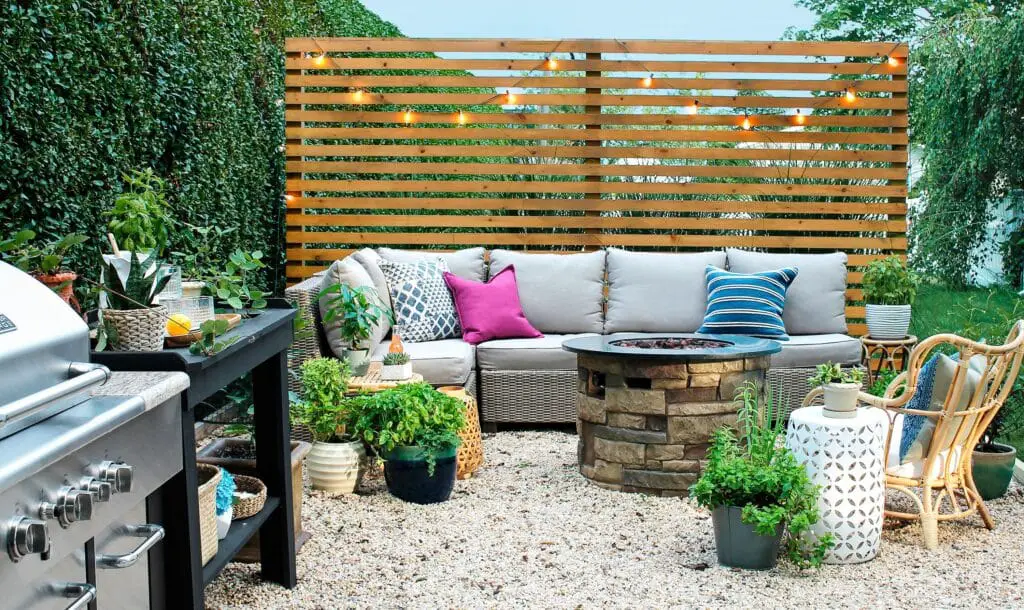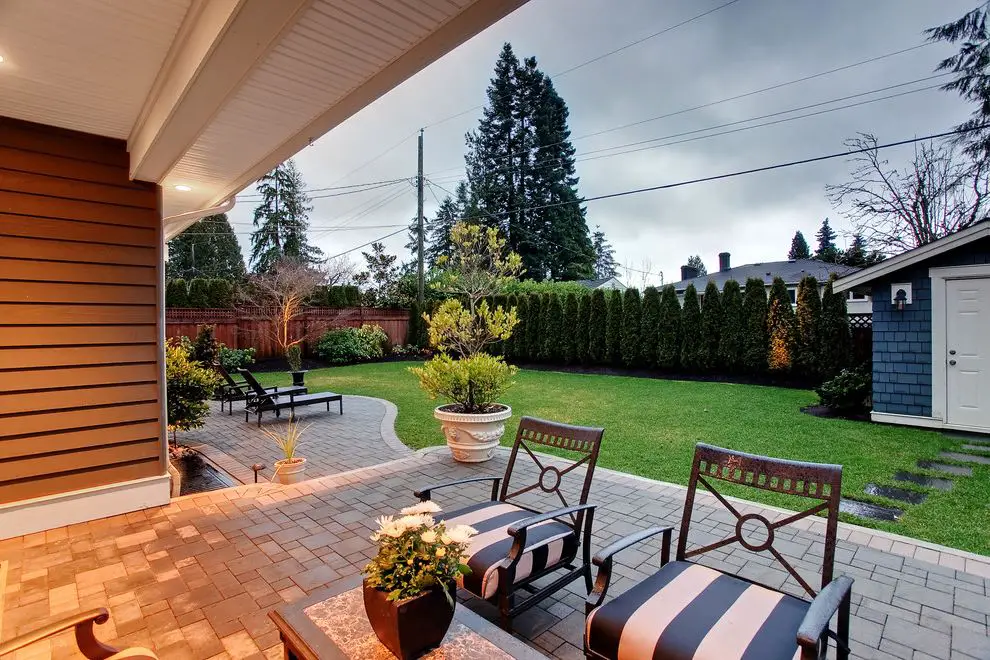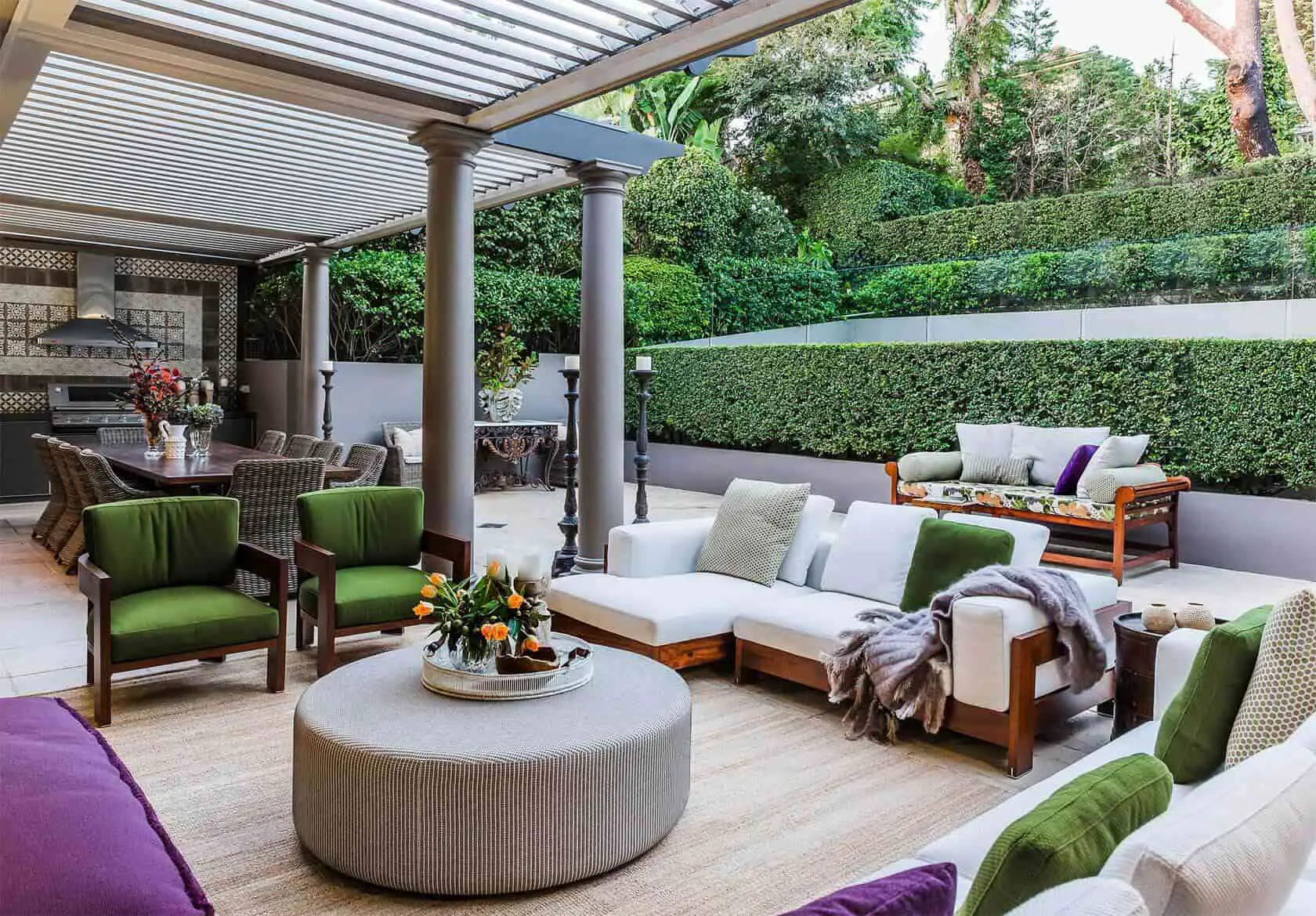How To Make Patio Private
Introduction
How To Make Patio Private: Do you long for a private outdoor space where you can relax and unwind without prying eyes? If so, you’re in luck! In this article, we will explore various ways to make your patio more private, allowing you to enjoy your outdoor oasis in peace.
One of the simplest and most effective ways to create privacy on your patio is by adding a fence or wall. This can be as simple as installing a lattice panel or as elaborate as building a brick wall. Not only will a fence or wall provide privacy, but it can also add a touch of style and elegance to your outdoor space. Consider using materials that complement the existing architecture of your home and landscaping for a cohesive look.
If you prefer a more natural approach to privacy, consider using plants to create a living barrier. Tall shrubs, trees, and climbing vines can all be used to block the view from neighboring properties. Bamboo is a popular choice for creating a natural privacy screen, as it patio furniture grows quickly and densely. Planting a variety of evergreen trees and shrubs will ensure year-round privacy, even in the colder months.
In addition to fences, walls, and plants, there are other creative ways to make your patio more private. Consider installing outdoor curtains or blinds that can be drawn closed when you want to block the view. These can be easily hung from a pergola or other structure and come in a variety of colors and patterns to suit your style. Another option is to use decorative screens or room dividers to create a sense of privacy. These can be easily moved and repositioned as needed, allowing you to customize your patio’s privacy level.

How can I make my backyard privacy without a fence?
15 Ideas for Better Backyard Privacy
- Create a Peaceful Space. 1/16. …
- Construct a Classic. 2/16. …
- Grow a Living Fence. 3/16. …
- Fill in with Bamboo. 4/16. …
- Fold Out a Private Enclave. 5/16. …
- Put Up a Pergola. 6/16. …
- Plant Your Pergola. 7/16. …
- Hang Out with Your Greenery. 8/16.
1. Planting Trees and Shrubs: One of the most natural and aesthetically pleasing ways to create privacy in your backyard is by planting trees and shrubs strategically. Choose fast-growing varieties that will quickly fill in the space and create a dense barrier. Evergreen trees and shrubs are particularly effective as they provide year-round privacy.
2. Installing a Privacy Screen: Privacy screens are a versatile option that can be easily installed and customized to fit your backyard’s specific needs. These screens can be made from various materials such as wood, metal, or fabric, and can be placed strategically to block the view from certain angles.
3. Building a Living Wall: A living wall, also known as a vertical garden, is a unique and visually appealing way to add privacy to your backyard. By planting a variety of plants on a vertical structure, you can create a lush and green wall that not only provides privacy but also adds beauty and texture to your outdoor space.
4. Using Outdoor Curtains: Outdoor curtains are a simple and affordable solution to create privacy in your backyard. These curtains can be hung from a pergola, gazebo, or even a clothesline, and can be easily opened or closed as needed. Choose curtains made from weather-resistant materials to ensure durability.
How can I get privacy from overlooking my Neighbours?
Solid board fences are one of the simplest ways to get privacy. The gaps between the wood boards are small enough that a nosy neighbor can’t see through them, and a tall fence will stop them from seeing over it. Invest in a wood board fence that’s 6 feet (1.8 m) tall and stretches around the space you want to shield.
Privacy is an important aspect of our lives, especially when it comes to our homes. Having privacy from overlooking neighbors can be a challenge, but there are several ways to achieve it. Whether you live in a suburban neighborhood or an urban apartment building, there are solutions that can help you create a private space.
One option is to install privacy screens or fences in your yard or balcony. These can be made of various materials such as wood, vinyl, or metal, and can be customized to fit your specific needs and preferences. Privacy screens can provide a physical barrier between you and your neighbors, blocking their view into your space. They can also add an aesthetic element to your outdoor area, enhancing its overall appeal.
privacy screens or fences
Another way to get privacy from overlooking neighbors is by using window coverings. Blinds, curtains, or shades can be installed on your windows to prevent others from seeing inside your home. You can choose from a variety of options, such as blackout curtains or sheer blinds, depending on the level of privacy you desire. Window coverings not only offer privacy but also allow you to control the amount of natural light that enters your space.
If you have a balcony or patio, consider using outdoor curtains or shades. These can be hung from a rod or attached to a pergola, providing a sense of enclosure and privacy. Outdoor curtains are available in different colors and patterns, allowing you to create a stylish and private outdoor space. They can also help block out the sun and provide shade during hot summer days.
How do I add privacy to an existing deck?
18 Deck Privacy Ideas for Quiet Comfort
- Privacy fencing.
- Privacy railing.
- Stone walls.
- Decorative panels.
- Lattice fencing.
- Garden covers.
- Ornamental trees.
- Trellises.
Adding privacy to an existing deck can be a great way to create a more intimate and secluded outdoor space. Whether you want to block out the view from neighboring properties or simply create a cozy atmosphere, there are several options available to enhance the privacy of your deck.
One of the simplest ways to add privacy to an existing deck is by installing a privacy screen or fence. These can be made from a variety of materials, such as wood, vinyl, or metal, and can be customized to match the style of your deck. Privacy screens can be freestanding or attached to the deck railing, providing a barrier between your deck and the surrounding area. They can also be designed to be adjustable, allowing you to control the amount of privacy you desire.
Another option to add privacy to an existing deck
If you prefer a more natural look, you can consider adding plants or trees to your deck. Tall shrubs or potted plants can be strategically placed to create a green wall that blocks the view from neighboring properties. You can also use trellises or lattice panels to support climbing plants, such as ivy or jasmine, which will grow and provide additional privacy over time. Not only will these plants add privacy, but they will also add beauty and a touch of nature to your deck.
Another option to add privacy to an existing deck is by using outdoor curtains or blinds. These can be hung from the roof or sides of your deck to create a private and shaded area. Outdoor curtains are available in a variety of colors and patterns, allowing you to customize the look of your deck. They can also be easily opened or closed, giving you the flexibility to adjust the level of privacy and sunlight as needed.
How to make cheap privacy fence?
Best Materials for a DIY Privacy Fence. Wood has long been and continues to be a popular material for privacy fencing. Fence wood, usually cedar or pine, is plentiful, relatively inexpensive, and simple to work with. Wood-composite and vinyl are good materials for privacy fences, too.
Privacy fences are a great way to create a secluded and secure space in your backyard. However, the cost of installing a privacy fence can often be a deterrent for many homeowners. Fortunately, there are several ways to make a cheap privacy fence without compromising on quality or aesthetics. In this article, we will explore some cost-effective options for creating a privacy fence that fits your budget.
Materials:
One of the key factors in making a cheap privacy fence is selecting the right materials. Instead of opting for expensive wood or metal, consider using more affordable alternatives such as vinyl or bamboo. Vinyl fences are durable, low-maintenance, and come in a variety of styles and colors. Bamboo fences, on the other hand, offer a natural and eco-friendly option that can be quite cost-effective.
DIY vs. Professional Installation:
Another way to save money on a privacy fence is by opting for a do-it-yourself (DIY) installation instead of hiring professionals. DIY projects allow you to cut down on labor costs and give you the flexibility to choose materials that fit your budget. However, it is important to note that installing a fence requires some level of skill and expertise. If you are not confident in your abilities, it may be worth investing in professional installation to ensure a sturdy and secure fence.
How do you make a homemade privacy fence?
- Whether building a board-and-stringer fence or a pre-fabricated panel fence, the first step is to set the fence posts.
- Obtain a Fence Permit.
- Mark Services at Fence Location.
- Stake the Fence Run.
- Mark the Fence Post Locations.
- Dig Fence Posts.
- Rest Fence Posts in Holes.
- Set Fence Posts in Concrete.
- Cut Tops of Fence Posts.
Making a homemade privacy fence can be a great way to add some extra privacy and security to your property. Whether you want to keep nosy neighbors at bay or create a safe space for your children and pets to play, a privacy fence can be a valuable addition to your home. While the process may seem daunting, with the right tools and materials, you can easily create a homemade privacy fence that suits your needs and budget.
Making a homemade privacy
Firstly, you will need to determine the location and dimensions of your privacy fence. Measure the area where you want to install the fence and mark the boundaries. This will help you determine the amount of materials you will need to purchase. It is also important to check with your local building codes and regulations to ensure that you are following any necessary guidelines.
Next, gather all the necessary materials and tools. This may include fence posts, panels, nails or screws, a post hole digger, a level, and a saw. You can purchase these items from a local home improvement store or online. Make sure to choose materials that are durable and weather-resistant, as they will be exposed to the elements.
Once you have all the materials, start by digging the post holes. Use a post hole digger to create holes that are deep enough to support the height of your fence. The depth will depend on the type of soil in your area and the height of your fence. It is recommended to dig the holes at least 2 feet deep to ensure stability.
After the post holes are dug, place the fence posts in the holes and fill them with concrete. This will provide a solid foundation for your fence. Use a level to ensure that the posts are straight and level. Allow the concrete to dry and set according to the manufacturer’s instructions
Are there any specific materials or plants that can be used to make a patio more private?
Yes, there are several specific materials and plants that can be used to create privacy in a patio. One popular option is to install privacy screens or fences made of materials such as wood, bamboo, or metal. These screens can be placed strategically around the patio to block the view from neighboring properties or public areas. Another option is to use outdoor curtains or shades that can be drawn closed when privacy is desired.
In terms of plants, there are many options that can provide both privacy and beauty. Tall shrubs or hedges, such as arborvitae or boxwood, can be planted along the perimeter of the patio to create a natural barrier. Climbing plants, such as ivy or wisteria, can be trained to grow on trellises or pergolas, providing both privacy and a lush, green backdrop. Additionally, tall grasses or bamboo can be planted in containers or raised beds to add height and create a sense of seclusion.
Are there any DIY techniques or projects that can be done to enhance privacy in a patio?
Yes, there are several DIY techniques and projects that can be done to enhance privacy in a patio. One popular option is to build a privacy screen or fence. This can be done using materials such as wood, bamboo, or even PVC pipes. By constructing a screen or fence around your patio, you can create a barrier that blocks the view from neighboring properties or passersby. You can also add curtains or outdoor blinds to your patio area to provide additional privacy. These can be easily installed and can be drawn closed when privacy is desired.
Another DIY technique to enhance privacy in a patio is to create a living wall or vertical garden. This involves using plants and vines to cover a trellis or wall, creating a natural barrier that adds both privacy and beauty to your patio. There are many types of plants that are suitable for this purpose, such as climbing roses, ivy, or even tall grasses. Additionally, you can use decorative screens or panels to add privacy to your patio. These can be made from materials such as metal, wood, or even recycled materials, and can be customized to match your desired aesthetic.
Are there any legal restrictions or regulations to consider when making a patio more private?
When it comes to making a patio more private, it is important to consider any legal restrictions or regulations that may be in place. These regulations can vary depending on your location and the specific rules set by your local government or homeowners association. It is always a good idea to check with your local authorities or consult a professional to ensure that you are in compliance with any applicable laws.
One common restriction to consider is the height of any structures or barriers you plan to install. Many areas have specific height limits for fences, walls, or other privacy structures. These limits are often in place to maintain a certain aesthetic or to ensure that neighboring properties are not negatively impacted. It is important to familiarize yourself with these height restrictions and obtain any necessary permits before proceeding with your privacy-enhancing projects.
Can you provide any tips or recommendations for maintaining privacy in a patio without compromising aesthetics?
Maintaining privacy in a patio while still maintaining an aesthetically pleasing environment can be a challenge, but it is certainly possible with the right techniques and choices. One tip is to strategically place tall plants or trees around the perimeter of the patio. These can act as natural barriers, blocking the view from neighboring properties or passersby. Opt for plants that are dense and have thick foliage, such as bamboo, arborvitae, or tall grasses. These not only provide privacy but also add a touch of greenery and beauty to the patio.
Another recommendation is to use decorative screens or partitions. These can be made from various materials such as wood, metal, or even fabric. Choose a design that complements the overall style of the patio and provides the desired level of privacy. Screens can be placed strategically to block certain angles or create secluded areas within the patio. They can also be used as a backdrop for other decorative elements, such as hanging plants or outdoor artwork.

Conclusion
Creating a private and secluded patio space can greatly enhance the enjoyment and relaxation of your outdoor living area. Whether you live in a bustling city or a suburban neighborhood, having a private patio allows you to escape from the outside world and create a peaceful oasis right in your own backyard. There are several effective ways to make your patio more private, ranging from simple and affordable options to more elaborate and expensive solutions.
One of the easiest and most cost-effective ways to create patio privacy on your patio is by using outdoor curtains or blinds. These can be hung from a pergola, awning, or even a simple curtain rod. Outdoor curtains not only provide privacy, but they also add a touch of elegance and style to your patio. You can choose from a wide range of colors and patterns to match your outdoor decor. Additionally, outdoor curtains can help block out the sun and provide shade on hot summer days.
Another popular option for creating privacy on your patio is by using plants. Tall hedges, shrubs, or trees can be strategically planted around the perimeter of your patio to create a natural barrier. Bamboo is a particularly popular choice, as it grows quickly and can provide instant privacy. You can also use trellises or lattice panels to grow climbing plants, such as ivy or jasmine, which will create a beautiful and fragrant wall of greenery.








